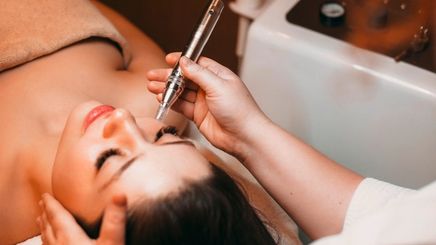
Pricking your skin with needles over a hundred times sounds more like torture than a beauty treatment, but such is the concept of microneedling for acne scars. It’s a minimally invasive procedure that promises a smooth and even-toned complexion.
Microneedling benefits go beyond fading pigmentation. In recent years, it has also become the gold standard for , , and even . Overall, it’s an all-in-one wonder.
You may have the urge to speed-book this treatment if those from acne keep bugging you. Before you do, read up on the science and the risks behind microneedling so you’ll feel more confident in your choice.
Is Microneedling Good for Acne Scars?
Microneedling for acne scars is anything but an overhyped trend – it’s backed by experts. According to the , it can reduce the visibility of (a.k.a. indented marks) and by 50% to 70%.
What is microneedling and how does it work, you ask? Also known as collagen induction therapy, it involves the use of a device equipped with fine, sterilized needles that create controlled micro-injuries on the skin’s surface. This procedure stimulates the natural healing process and breaks up old skin cells to make way for new ones.
Moreover, the pins trigger and elastin production. Collagen, the protein responsible for skin structure and firmness, rushes to repair the “wounded” skin and smoothen uneven textures. Meanwhile, elastin contributes to restoring skin elasticity, which results in a plump and bouncy complexion. Your may also look less obvious– a welcome bonus.
Does Microneedling Hurt?
Microneedling always comes with some discomfort because, well, your skin is being stabbed repeatedly with tiny needles. But the intensity of the sensation is subjective.
Some people would say it’s less painful than , while others hardly feel a thing. Factors like your pain threshold, skin sensitivity, and how long the practitioner leaves the numbing cream on before the procedure influence the pain meter, too. It’s more unpleasant around the bony parts of the face, like the forehead and jawlines, since these areas have less fatty tissue for cushioning.
If you’re worried about the pain, let your dermatologist know so they can work some things out to ensure your comfort.
How Long Before You See Results From Microneedling?
Microneedling for acne scars promises many things, but instant results are not one of them. Swelling and red bruises are common after a session and can last a few hours to a couple of days. Post-treatment side effects should subside after two weeks, revealing radiant and .
To see long-lasting improvements, you may need three to five sessions, each performed four weeks apart. Of course, this entirely depends on the type of scars, their severity, and your skin characteristics.
Who Should Not Try Microneedling for Acne Scars?
Those with active breakouts, , , and psoriasis should approach microneedling with caution. The microscopic punctures can worsen these skin issues, so always consult a dermatologist. Other conditions that may not be ideal for microneedling include a compromised immune system, a history of keloids, diabetes, and .
If you want the results of microneedling but are not thrilled about needles, there are alternative in-office treatments that offer similar benefits:
- : It uses heat from infrared lasers to minimize the appearance of acne marks. It can also help prevent raised scars.
- : It works by exfoliating the top layer of the skin. Stronger chemical solutions are better at treating deep scarring, but they also come with increased downtime and more side effects.
- Microdermabrasion: The process is like microneedling, only it uses a diamond-tipped wand and a vacuum system. It causes little to no pain and almost zero recovery period, though the result is more subtle.
What to Do After the Treatment
Give your skin some time to chill after a session of microneedling. Immediately post-treatment, the technician will apply a soothing and hydrating cream to help relieve the swelling. For the next two days, your skincare ritual should consist of only water to cleanse your face. Avoid putting on makeup or products with active ingredients or doing activities that will make you sweat. Most importantly, stay out of the sun at all costs.
Once most after-effects have calmed down, you can slowly ease into your usual AM and PM skincare routine. Use the double cleansing method to help keep your skin acne-free for as long as possible.
Wipe away any impurities using Eskinol Pimple Relief Micellar Water and follow with Eskinol Pimple Relief Facial Wash. These two products combine cica, green tea extracts, and niacinamide to help unclog pores and heal acne faster.
Excited to give microneedling for acne scars a go? Considering the benefits and high success rate, it’s still one of the most effective solutions for improving skin texture. That said, it’s wise to first consult with a professional who can assess your skin’s unique needs and guide you through the process.